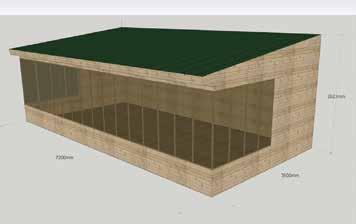
2 minute read
Rainton reedbed gets underway
An update from around the reserves, by Mark Dinning
Rainton reedbed gets underway
Advertisement
Mark Dinning
Head of Conservation
October saw ground being broken on the latest addition to wetland habitats at Rainton Meadows. The new one hectare reedbed has been made possible by funding from Biffa Award, Sunderland City Council, Northumbrian Water, Heritage Concern Foundation, the Hamamelis Trust, and E.ON Great Eppleton Wind Farm Community Benefits Fund via County Durham Community Foundation. Work will be ongoing through the winter to develop habitats that will provide a home to species including otter, reed bunting, reed warbler and starling.
Wear Wetlands
As part of wider partnership work with the Environment Agency and land owners, change is coming to the mid-Wear. This winter will see the delivery of the first of what is hoped to be a number of habitat improvements along the mid-Wear corridor. Starting with work at Durham Wildlife Trust’s Low Barns Nature Reserve to remove excess silt from Marston Lake, which has built up and is now preventing effective water level management. Scoping work will also be carried out to begin to evaluate the impact the collapsed ford across the Wear has on the river’s morphology, with a view to the potential removal of the structure in 2022. It is hoped that continued funding in coming years will be used to restore many of the water-dependent habitats along the river from Stanhope to Bishop Middleham.
Community Conservation Returns
Our successful Community Conservation citizen science project is returning in spring 2022, with lots of opportunities to get involved. Understanding how some often overlooked species are responding to climate and habitat change in our county will be one of the main tasks for 2022. Previous years have seen amateur wildlife enthusiasts undertake surveys to support conservation of the dingy skipper butterfly, identify important dragonfly sites, and get up close with Emperor moths through the use of pheromone lures. The focus this spring will be two overlooked moths - the red-tipped clearwing and the large red-belted clearwing. The red-tipped is associated with water stressed willow, a key component of many habitats along the mid-Wear wetlands. The large red-belted has seen a significant population decline in the last ten years, even though it is associated with the widespread silver birch. Surveys will also be investigating the Brimstone butterfly, developing long-term monitoring of this species and its larval foodplant, the alder buckthorn. For more details visit: durhamwt.com/community-conservation
Red-belted clearwing moth by Margaret Holland
New base for Rangers and schools at Low Barns
This winter, a new base for the Nature Rangers and Young Rangers will be unveiled at Low Barns. Situated overlooking Marston Lake, this will be an easily accessible glass-fronted hide, only a few yards from the visitor centre. Designed to provide a base for the Ranger groups, and when not in use by the Rangers or schools, also offer visitors a comfortable view of the bird life on the lake throughout the year. The hide is being delivered thanks to funding from Northumbrian Water, Weardale Area Action Partnership, and the Scotto Trust.










